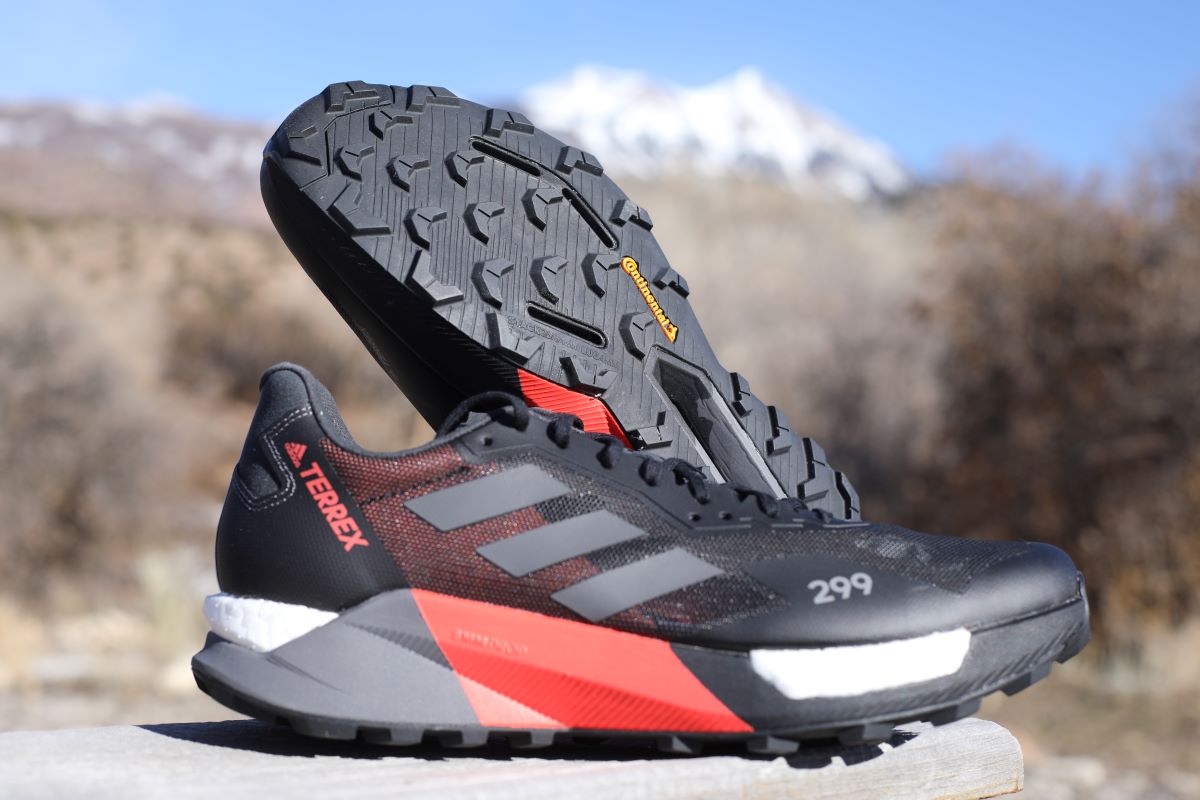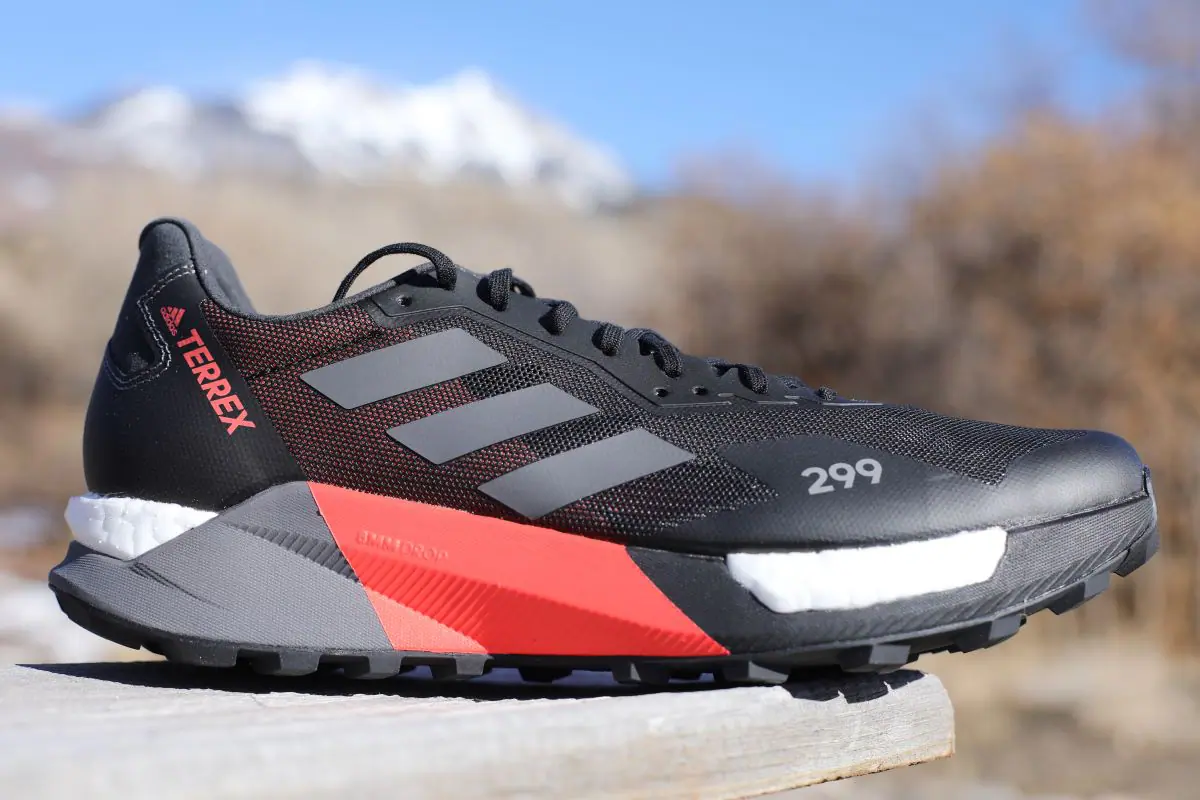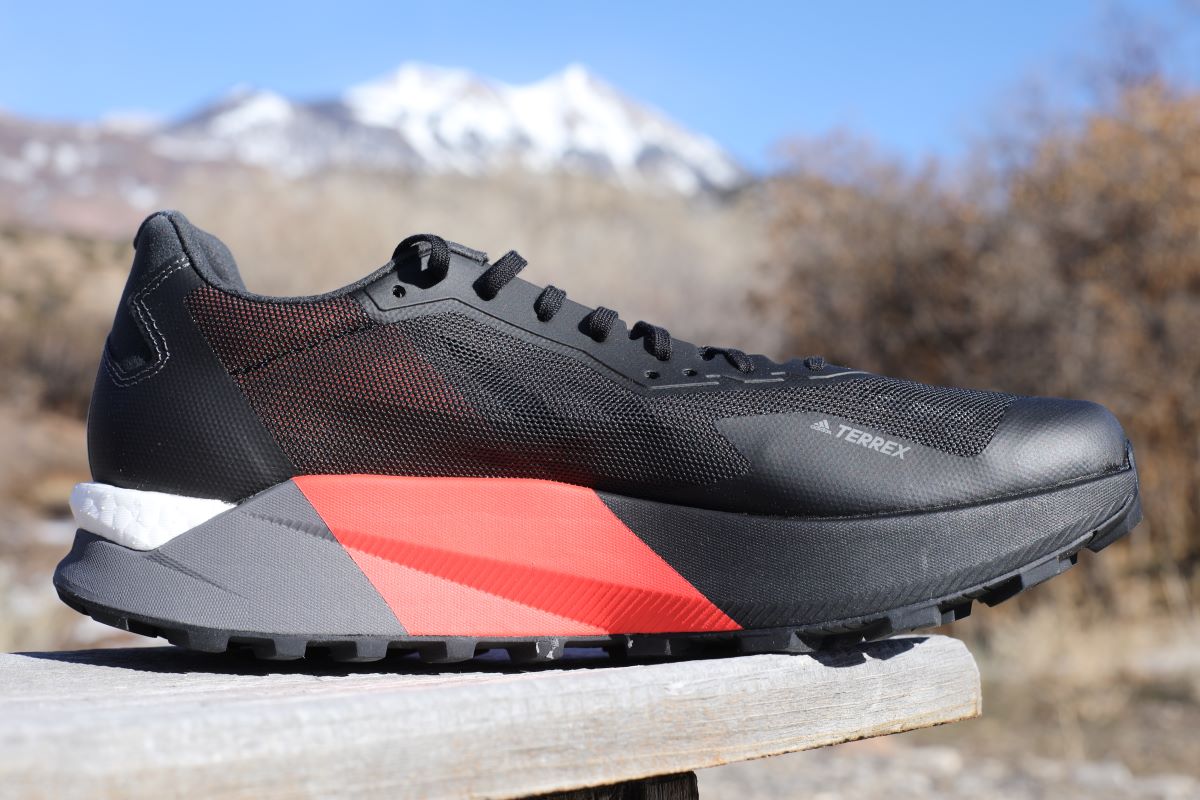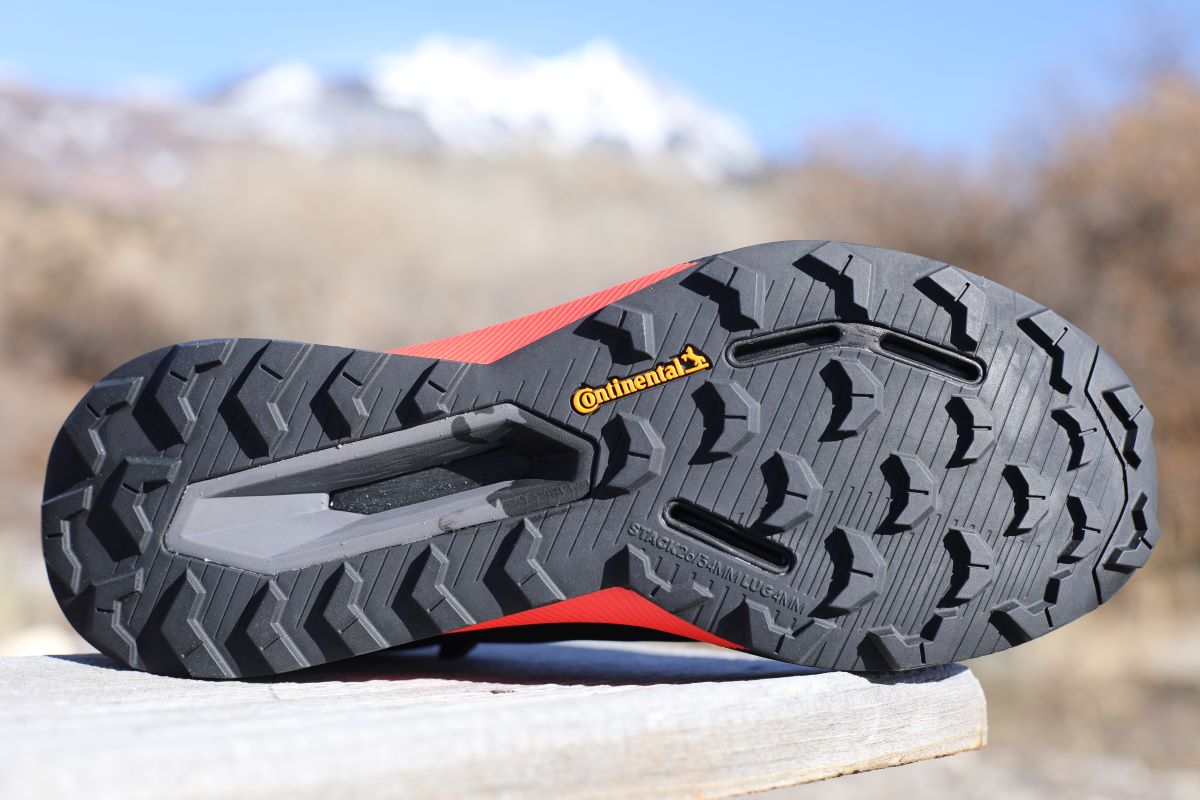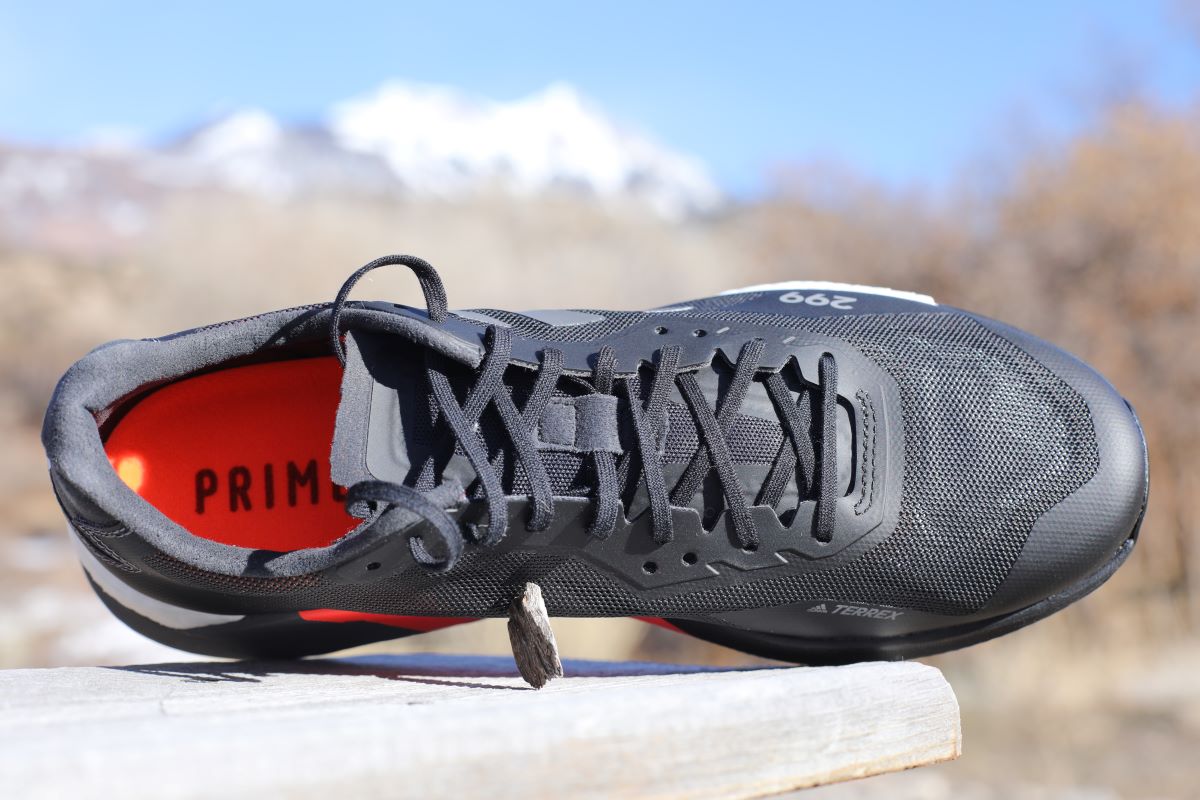Never have I ever worn a shoe that I hated so much at the beginning, and loved so much by the end. Part of my initial dislike for the adidas Terrex Agravic Ultra ($160) I attribute to my lack of experience with a wide variety of trail shoes. I’ve been exploring the trails for less than two years, and all other trail running shoes I’ve worn and loved — such as the Hoka Speedgoat line, the Brooks Catamount, the Scarpa Spin Infinity, and the Nike Wildhorse line — have felt soft, squishy, and easy to wear right out of the box. Not so for the adidas Terrex Agravic Ultra.
At an actual weight of 11.6 ounces (328 grams) for a men’s size 9, this is not a lightweight shoe, nor is it minimalist, with a 38-millimeter stack height at the heel and an 8-millimeter drop. Despite the large amount of cushion, this shoe does not feel soft right out of the box; it feels like putting on an incredibly stiff, brand-new leather work boot.
However, it also serves the wearer exactly like a leather work boot: once broken in, it contours itself perfectly to the runner’s foot, almost becoming a part of the foot itself. The longer you wear this shoe, the better it gets, and unlike other shoes where longer runs or excess milage may make the midsole pack down and feel boggy, the Agravic Ultra only gets better with time.
I know the initial paragraphs of this review may sound highly critical, and one would think, well, why are you reviewing this shoe? Fear not, for once I overcame the stiffness issues, everything else on this shoe, I absolutely loved. There are certainly flaws in the Agravic Ultra, including a strangely high-cut ankle collar and excessively long laces, but after making friends with this shoe, it’s one I reach for very often.
The iRunFar team loves this shoe enough that we named it one of the top shoes in our best cushioned trail running shoes guide.
Shop the Women's adidas Terrex Agravic UltraShop the Men's adidas Terrex Agravic Ultra
adidas Terrex Agravic Ultra Upper
Leading the way among shoe manufacturers in sustainability, the adidas Terrex Agravic Ultra is made of at least 50% recycled materials, which is likely part of the reason why it is so stiff.
Once you’ve tied yourself into this shoe, you aren’t going to come out. The inflexibility of the upper creates such great security, I haven’t had to stop to retie or adjust the laces during a run at all. However, that also means that it is absolutely impossible to just slip your feet into the shoes without untying them first.
There are a few standout pieces for me on the upper: both great things and other elements that take a while to get used to. Starting at the back of the shoe, the heel cup is the most leather-like part of the shoe, with the very back rising quite high on the ankle, in a way that it may irritate those with existing Achilles tendon problems.
Continuing around to the ankle, the ankle cuff is also oddly high cut, and it constantly rubbed under my ankle bone for the first week of wearing this shoe around. Maybe it’s just my foot shape, but running socks that cover the ankle bones were an absolute must. These two elements were the two things that gave me an initial bad impression of this shoe, however, once I broke them in, they gave me no issues and my impression of the shoe completely switched. I would personally suggest walking in these shoes around the house and town for a week before running in them, as I did, to soften them up.
Moving further forward on the shoe, the rest of the upper is also made of similarly recycled material, in this case, an incredibly breathable and drainable mesh, adorned with the adidas three stripes on each side. While other highly cushioned shoes may continue that cushioning in the sides and top of the upper, the Agravic Ultra is surprisingly and thankfully minimalist in this regard. If and when this shoe gets wet or muddy, it dries rapidly and doesn’t get caked with crud or get stinky.
Thicker recycled material also adorns the upper where the laces connect and atop the tongue, which is thin. While the tongue is not gusseted, it stays in place, not sliding to one side or another. This is one of my pet peeves and happens to me with nearly every shoe I’ve tried, so I was grateful this tongue stayed put!
The breathable material continues to the forefoot, until the front, which is covered with a very solid toe guard. I’m not the most graceful runner, and it’s inevitable that I kick at least one rock on every trail, so this protection has been much appreciated.
The last element of the upper I’ll mention is more of an annoyance than a real problem: all adidas shoes I’ve tried have incredibly long laces. I have a pretty wide foot and thus never have to cinch my shoes down, so one would think I’d appreciate longer laces, but these are loooooooong. With no garage for the laces, they flop around a lot. Adidas, please cut off about two inches from your laces! However, I do appreciate the lace material: not overly puffy, not thin strings of a quicklace system, just basic solid laces that stay tied.
adidas Terrex Agravic Ultra Midsole
The midsole of the adidas Terrex Agravic Ultra is where the technical specifications of this shoe really shine. Though at first blush the midsole is firm, I discovered that firmness doesn’t mean a lack of cushion. The combination of three elements makes this shoe’s midsole supportive, reactive, and durable: BOOST and Lightstrike foams, which are both proprietary adidas foams, and a bio-based TPE carbon plate.
BOOST is adidas’s most well-known foam, introduced in 2013 and used on nearly every single shoe since. It is very visible on the outside of the shoe under the heel and at the ball of the foot: BOOST looks like a bunch of little bubbles. Adidas claims that BOOST is beneficial for its responsiveness and comfort — it is tangibly softer than the rest of the midsole. Lightstrike originally debuted in adidas basketball shoes, claiming to provide superior lightweight support, responsiveness, and durability. This section of midsole is noticeably firmer in the arches, outside of the foot, and right under the toes.
While road shoes have incorporated carbon plates for a few years now, “supershoes” are only just starting to make their way into the trail world — accompanied by the discussion on whether or not carbon plates are worth it in trail shoes at all. The TPE plate on the Agravic Ultra is made of 90% recycled carbon materials, another nod to adidas’s commitment to sustainability.
This plate serves a few purposes that were noticeable while wearing the shoe. First of all, it makes the shoe feel stiffer, and thus, keep its shape for longer runs and more miles. Next, it serves as a protective layer, similar to a traditional rock plate, except this carbon plate runs the length of the shoe. Finally, it does provide some responsiveness that makes the midsole feel quite snappy.
Put all these elements together and you have a midsole that is extremely firm at first wear, but its cushion feels better and better with every mile as the shoe forms to your feet and retains its structural integrity.
adidas Terrex Agravic Ultra Outsole
The adidas Terrex Agravic Ultra has an outsole that seems to perform extremely well in almost all conditions. I’ve run on a variety of terrain with this shoe, from buffed-out rolling trails, steep and rocky ascents, and descents, on slickrock, and even road-to-trail connectors. The Continental rubber outsole is very sticky and has performed well on all types of terrain. Given that these shoes were tested where I live in Flagstaff, Arizona, I haven’t gotten a chance to run in very muddy or snowy conditions with them, but other iRunFar team members say they perform admirably in the damp as well.
The 4-millimeter lugs are spaced out well enough to grasp the trail well. On the forefoot, they are arrow-shaped, pointed forward in the direction of travel. On the arch area to the heel, they’re pointed backward, designed to catch you on steep ups or downs.
My one complaint about the outsole of this shoe is the large cutout under the midfoot. I imagine this was done to save on weight, but I’ve gotten stones caught in there a number of times, which is an annoyance.
adidas Terrex Agravic Ultra Overall Impressions
The adidas Terrex Agravic Ultra is a well-cushioned shoe that was made with sustainability and durability in mind, with comfort coming in third, as a gift only for the patient.
I am quite a low-mileage runner, so I have taken this shoe on runs up to 15 miles. Up to that point, and likely far beyond, it performs admirably, though it takes a mile or two to really feel comfy. I liken this shoe to a piece of heavy machinery or a diesel engine: takes a while to warm up, but will last for ages without any real problems. If you’re patient enough break in these shoes before a really long effort, you will be well rewarded with a shoe that will carry you far.
To learn a little more about why we named it one of the best cushioned trail running shoes, read our best cushioned trail running shoes guide.
Shop the Women's adidas Terrex Agravic UltraShop the Men's adidas Terrex Agravic Ultra
Call for Comments
- Have you run in the adidas Terrex Agravic Ultra? How have you found it?
- Have you tried any other adidas trail running shoes that you preferred?
